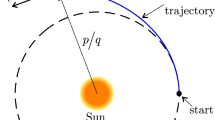Abstract
Ideal solar sails are perfectly flat, rigid, and reflective, can hold arbitrary sun angles perfectly, etc. Real sails are very different. Yet much preliminary mission analysis is done with ideal sails, on the assumption that the only important effect of non-ideal behavior is slightly reduced performance. This assumption is often false. Real sails simply cannot fly some mission plans that look plausible for ideal sails, and in other cases, realistic mission design and realistic sailcraft design much consider some aspects of non-ideal sail behavior from the start.
Access this chapter
Tax calculation will be finalised at checkout
Purchases are for personal use only
Preview
Unable to display preview. Download preview PDF.
Similar content being viewed by others
References
McInnes, Colin R., Solar Sailing: Technology, Dynamics, and Mission Applications, Springer-Praxis, Chichester, UK, 1999.
Campbell, Bruce A., “Description of a Realistic Solar Sail and Comparison to an Ideal Sail,” 2nd International Symposium on Solar Sailing, City University of New York, New York, 2010.
Lichodziejewski, David; Derbes, Billy; et al, “Development and ground testing of a compactly stowed scalable inflatably deployed solar sail,” AIAA 2004-1507, 2004.
Forward, Robert L., “Statite: A Spacecraft That Does Not Orbit,” Journal of Spacecraft and Rockets, Vol. 28, No. 5, pp. 606-611, 1991. doi: 10.2514/3.26287.
McInnes, Colin R., McDonald, A.J.C., Simmons, J.F.L. and MacDonald, E.W., “Solar Sail Parking in Restricted Three-Body Systems,” Journal of Guidance, Dynamics and Control, Vol. 17, No. 2, pp. 399-406, 1994. doi: 10.2514/3.21211.
Carroll, Kieran. A., “POLARES Solar Sail Feasibility Study Results, Part 1,” Dynacon Tech. Memo. TM 39 306/04 1, 8 October 1993.
McInnes, C.R., “Artificial Lagrange Points for a Partially Reflecting Flat Solar Sail,” Journal of Guidance, Control, and Dynamics, January, Vol. 22, No. 1 : pp. 185-187. doi: 10.2514/2.7627.
Chen-wan, L. Yen., “Solar Sail Geostorm Warning Mission Design,” AAS 04-107, 14th AAS/AIAA Space Flight Mechanics Conference, Maui, Hawaii, February 2004. http://hdl.handle.net/2014/38220.
Morrow, Esther, Scheeres, D.J. & Lubin, Dan, “Solar Sail Orbit Operations at Asteroids,” Journal of Spacecraft and Rockets, Vol. 38, No. 2, March-April 2001, pp. 279-286. doi: 10.2514/2.3682.
Samara State Technical University, Applied Mathematics and Information Science Department, Catalogue of the Solar System Small Bodies Orbital Evolution web-site, Asteroid General Data for asteroid 2004 GU9 (164207) http://smallbodies.ru/en/asteroids/info/general/2004_GU9/ [cited 23 May 2013].
Acknowledgments
Most of the work described in this paper was done for, or in association with, the Microsatellite Design Project graduate course offered by Space Flight Laboratory at the University of Toronto Institute for Aerospace Studies. (The authors are its instructors.) Several years’ classes have asked questions, raised issues, or come across problems that inspired much of this work. The spacecraft preliminary designs shown in sections IV and V are largely the work of the students. Dr. Robert E. Zee, the director of SFL, has allowed us to mercilessly exploit his students while we educate them, and has encouraged us to present them with design problems that go well beyond SFL’s more normal projects. The authors are grateful for the helpful information and advice provided by Nathan Barnes and Billy Derbes of L’Garde, Inc., regarding their solar sail technology.
Author information
Authors and Affiliations
Corresponding author
Editor information
Editors and Affiliations
Rights and permissions
Copyright information
© 2014 Springer-Verlag Berlin Heidelberg
About this chapter
Cite this chapter
Spencer, H., Carroll, K.A. (2014). Real Solar Sails are Not Ideal, and Yes It Matters. In: Macdonald, M. (eds) Advances in Solar Sailing. Springer Praxis Books(). Springer, Berlin, Heidelberg. https://doi.org/10.1007/978-3-642-34907-2_55
Download citation
DOI: https://doi.org/10.1007/978-3-642-34907-2_55
Published:
Publisher Name: Springer, Berlin, Heidelberg
Print ISBN: 978-3-642-34906-5
Online ISBN: 978-3-642-34907-2
eBook Packages: EngineeringEngineering (R0)




